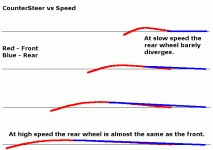John in CR
100 TW
Drunkskunk said:I prefer the weight up high. when seated on the bike, having the weight higher up means the center of mass is in a smaller area, and so the inertia is less when manuvering. tis a small detail, but you feel less stress in your hands and in your seat.
By an example, tie a 2 liter bottle of Coke to the bristle end of a broom, and try to sweep with it. then try it again while its tied up by your hand. Its a lot easier to sweep with it higher up, right?
Now, this has nothing to do with actual preformance, only with feel. having the weight low while sitting on the seat, to me, feels like sweeping with the bottle on the bristle end of the broom.
Now, standing up off the seat, that changes things. having the weight high feels unstable, especialy if the weight is over the back wheel.
Thats just my oppinion, and has nothing to do with actual preformance, just how it feels to me. We can discuss how to improve preformance elseware.
Drunkskunk,
Now you're getting into some really meaty stuff to discuss, and will probably include some stuff that Safe was on the right track about. I just felt compelled to discuss exactly where the "roll axis" existed.
I like your analogy of a weight and a broom, and want to throw something out there. I believe that where the weight is located front to back determines where it will feel like on your broom. If it's in the front then the bristle end will feel heavy and require more effort, because that weight must be slung from side to side during counter steer. Weight low in the back will still have the weight at the bristles, but you're moving the top of the broomstick back and forth with the bristle end staying still.
Once you stand up on the bike, the lateral movement of the bike will be back a forth on a roll axis much closer to the ground, so the higher the weight fixed to the bike, the more you feel it because more effort is required.
Everything keeps leading me back to as low as possible, as far to the rear as possible, without getting in the way while off the bike. As long as we make sure everything at the rear is strong enough to bear the weight, how far can we go with weight distribution toward the rear? Is there a certain amount or percentage of weight that we need on the front tire before we start running into problems?
John
John






